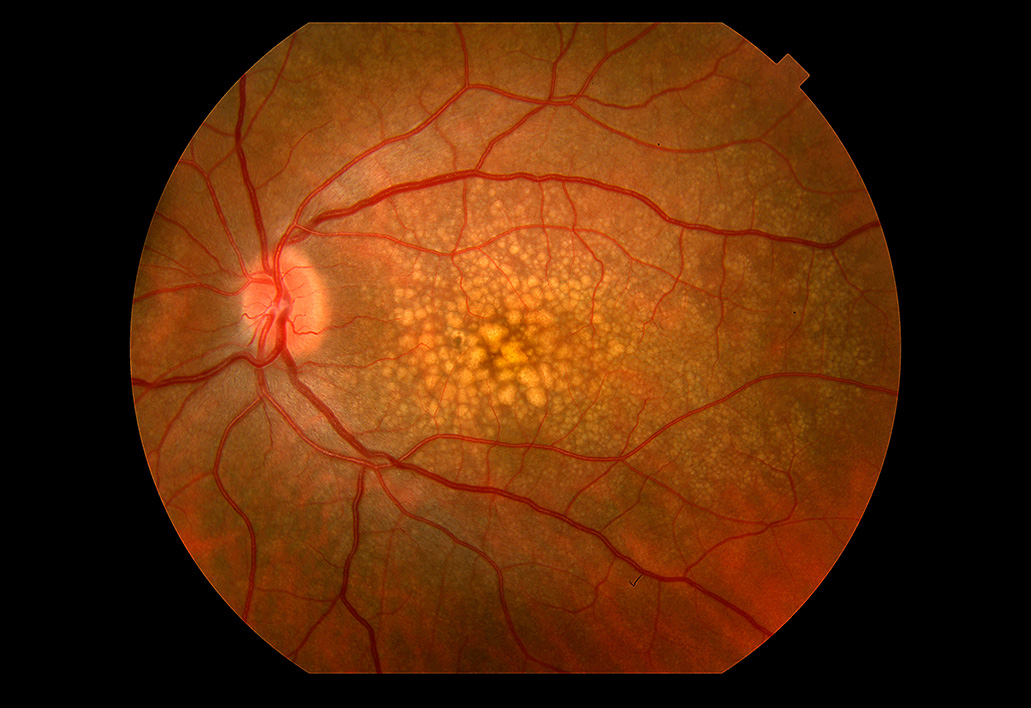
Drusen are yellow spots on the macula, located in the center of the retina.
Age-related macular degeneration, usually called AMD or macular degeneration, occurs when the central part of the retina, known as the macula, is damaged. When the center of the macula, called the fovea, becomes damaged, vision loss can be severe. The fovea is responsible for detailed vision, used for activities such as reading and recognizing faces.
Macular degeneration is the leading cause of severe vision loss in people 60 years of age or older in the United States and throughout many parts of the world. Although there is currently no cure to improve vision loss from macular degeneration, the good news is macular degeneration can be detected in its earlier stages, which is key in helping to preserve vision. With appropriate treatment, vision loss can be prevented or slowed in some people with macular degeneration.
Dry Macular Degeneration is the most common form of macular degeneration, representing approximately 90% of all AMD cases. However, dry macular degeneration accounts for only 10% of the severe vision loss associated with macular degeneration. Dry AMD is characterized by development of yellow-white deposits underneath your retina, known as drusen, and can also be determined by deterioration of your retina.
 |
Drusen are yellow spots on the macula, located in the center of the retina. |
There is no generally accepted treatment for dry macular degeneration, although vitamins, antioxidants, and zinc supplements may slow its progression. Over time, dry macular degeneration cases can develop into wet macular degeneration.
As dry macular degeneration worsens, you may see a blurred spot in the center of your vision. The most common symptom of dry macular degeneration is slightly blurred vision, and you may have difficulty recognizing faces. You may need more light for reading and performing other tasks. Dry macular degeneration often affects both eyes, but vision can be lost in one eye while the other eye seems unaffected. Over time, as less of the macula functions, central vision in the affected eye is gradually lost.
Wet Age-Related Macular Degeneration
Wet Macular Degeneration occurs when abnormal blood vessels start to grow on the center of your retina. These new blood vessels may be very fragile and often leak blood and fluid. The blood and fluid can damage your macula or create a scar on your retina, causing vision problems. Damage to the macula can occur rapidly, causing a noticeable loss of central vision. The vision loss from wet macular degeneration may be permanent, because abnormal blood vessels and scar tissue are actually replacing normal retina tissue. Once lost, these light-sensitive cells in your retina cannot be replaced.
An early symptom of wet macular degeneration is vision change, when straight lines appear wavy. For example, you may notice that your door frames appear wavy instead of straight. If you notice this condition or other changes in your vision, contact your eye care professional immediately for a comprehensive dilated eye exam. Treatments are available that may slow and reduce vision loss associated with wet macular degeneration. You should report any changes in vision to an eye care professional as soon as you notice them.
It is estimated that more than 2 million people in the United States currently have wet macular degeneration, with an increase of 200,000 new cases per year.
Who Gets Age-Related Macular Degeneration?
As the name suggests, age-related macular degeneration is more common in older adults. In fact, it is the leading cause of severe vision loss in adults over age 60.
Macular degeneration may be hereditary, meaning it can be passed on from parents to children. If someone in your family has or had the condition, you may be at higher risk for developing macular degeneration. Talk to your eye doctor about your individual risk. Vitamins for macular degeneration will likely be recommended.